East Prussian operation. Part of 1. Gumbinnen-Goldap Battle 7 (20) August 1914
However, in terms of big strategy, the German army was defeated. The invasion of two Russian armies in East Prussia and the defeat of the German 8 Army in the Battle of Gumbinnen (Gumbinnen) forced the German command to transfer two army corps and a cavalry division (120 thousand soldiers) from the Western Front, which seriously weakened the German troops before the decisive battle on marne. As a result, German troops were stopped at Marne, Schlieffen’s strategic plan was Moltke (The Great War: The Schlieffen Plan) was not implemented. Berlin failed with one decisive blow to defeat France and transfer troops to the East, against Russia. Russia saved France from heavy defeat. Germany had to wage war on two fronts - Western and Eastern, which in the long run meant defeat in the entire campaign. No wonder Marshal Foch concluded: “If France was not wiped out of Europe, then we owe it to Russia first of all, because the Russian army diverted some of its forces to itself and thus allowed us to win the Marne.”
Thus, the tactical success of the German army on the Eastern Front due to the transfer of troops from the Western Front led to the strategic defeat of Germany in the West. Germany had to wage a long war on two fronts. And in such a war, the resources of the Central Powers strongly lost to the economic, military-technical, human and raw material potential of the Entente countries. The Russian, British empires and France had an overwhelming advantage in the resource base, although at the beginning of the war they also did not count on a long campaign.
Moreover, in the course of the East Prussian operation, Germany was unable to assist its ally, the Austro-Hungarian Empire. This allowed the Russian army to defeat the Austro-Hungarian troops during the Battle of Galicia.
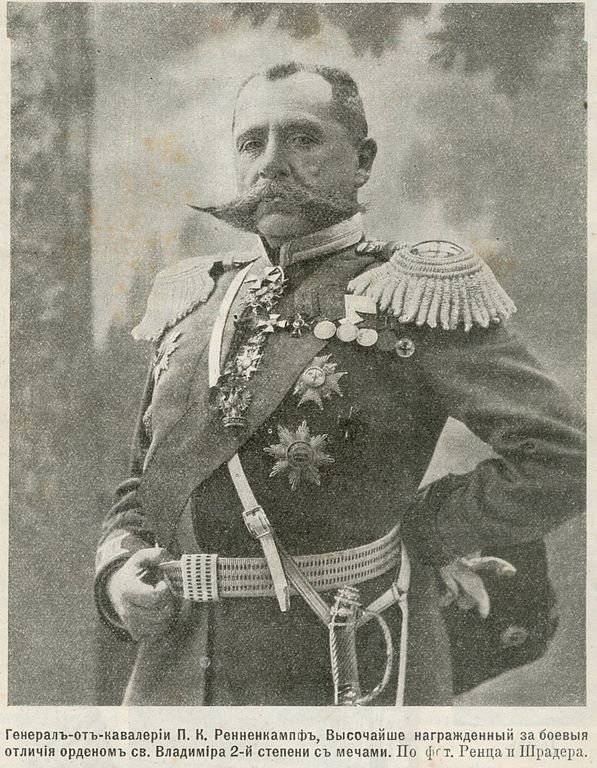
The forces of the parties
By August 17, the 1 corps of the Russian army under the command of cavalry general P. K. von Rennenkampf deployed in the original area of Vladislav-Suwalki. The 2 corps of the army under the command of A. V. Samsonov, the cavalry general, was deployed in the area of Augustów - Ostroleka - Novogeorgievsk. Both armies were part of the North-Western Front under the command of the cavalry general Ya. G. Zhilinsky.
By the beginning of operations in the Rennenkampf army there were 6,5 infantry and 5,5 cavalry divisions, 492 guns. The army of Samsonov included 12,5 infantry and 3 cavalry divisions, 720 guns. Total army of the North-Western Front numbered about 250 thousand people. After the mobilization was completed, the forces of the North-Western Front were to grow to 30 infantry and 9 cavalry divisions. He started the offensive without getting all the connections.
Russian troops opposed the German 8-I army under the command of Colonel-General Maximilian von Pritvitsa. In the German army there were 14,5 infantry and 1 cavalry divisions, around 1000 guns. Total German troops numbered about 173 thousand people. The main forces of the German army turned around in Insterburg-Gumbinnen-Ungerburg, Deutsch-Eylau-Allenstein.
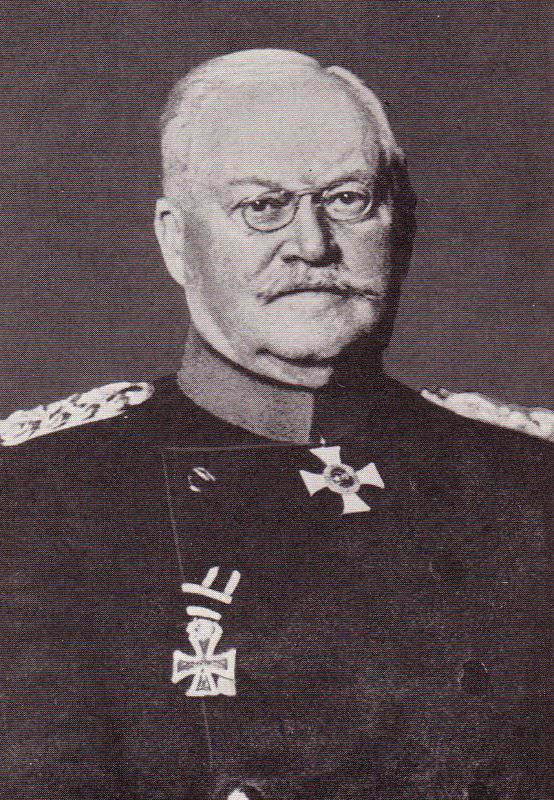
Maximilian von Pritvitz
Party plans
The Directive of the North-Western Front set before the two Russian armies the task of defeating the German troops left on the Eastern Front, to seize East Prussia, in order to gain the possibility of an offensive deep into Germany. On August 13, the task was clarified - the armies of Rennenkampf and Samsonov were to smash the enemy army and cut off German troops from Koenigsberg and from the Vistula.
To accomplish this task, the 1 Army had to cross the German border on 17 in August and put up a barrier in the Lettsin direction, advancing on the front of Insterburg and Angerburg bypassing the line of the Masurian lakes from the north to cover the enemy’s left flank. 2-I army received the task of crossing the border of Germany 19 August, moving from the line Avgustov, Grajewo, Myszyniec, Khorzhele, deliver the main blow to the front of Rudshany, Passenheim. Thus, Samsonov’s army was supposed to bypass the Mazursky lakes region from the west, striking the flank and rear of the German corps, which the Rennenkampf army was to attract.
Because of the mobilization rush (the top Russian command promised the French to launch an offensive as early as possible), from the very beginning of the offensive, the Russian armies experienced serious difficulties with reconnaissance, organizing the rear and establishing communications. Thus, the command of the 1 Army knew about the location of the enemy corps only approximately. Therefore, the Russian corps received vague tasks, and the Rennenkampf army entered East Prussia almost blindly. The supply in the rear of the army due to haste has not yet been organized. Having entered the German territory, the corps moved without any special connection, independently, as if in peacetime conditions. Yes, and the border crossed at different times between the 8 hour (3-th body) and 14 hour (4-th body). Thus, the prerequisites were created for the defeat of the corps of the Russian army separately.
There were other negative factors. In the Baltics, the situation with railways was better. The railways approached the border, and the troops could be moved from the entire Baltic states and the center of the Russian Empire. In Poland, in the concentration zone of the 2 Army, the situation was worse. Therefore, the two armies of the North-Western Front should begin fighting, not simultaneously, but in terms of readiness. Moreover, the High Command, having learned that the border with Poland in the Berlin direction was protected only by one Landwehr corps (territorial troops, secondary military formations in Germany), decided to strike another blow. The North-Western and South-Western fronts were to attack on the flanks, linking German and Austro-Hungarian troops, and in the Warsaw area they decided to create a new strike force that would threaten Berlin. As a result, the troops that were supposed to strengthen the 1 and 2 army, began to send to Warsaw on the formation of the 9 army. The impact force and reserves of the armies of Rennenkampf and Samsonov were weakened.
The German 8 Army received the following tasks: 1) to defend East Prussia before the transfer of troops from the Western Front, which they promised to start from the 42 day from the start of mobilization; 2) assist the advance of the Austro-Hungarian troops between the rivers Western Bug and Vistula; 3) retain the Lower Vistula region as a starting point for future offensive operations of the German army. The 8 Army did not receive a concrete plan of action. As a result, the command of the 8 Army could solve the task of defending East Prussia on its own, depending on the situation.
The command of the German army had the most superficial understanding of the enemy grouping. And if the Russian cavalry determined at least the contour arrangement of the enemy forces, then the Germans did not do that either. Therefore, like the Russians, the Germans approached the decisive battles almost blindly. The Germans only knew that the Russians had cleared left-bank Poland — the troops of 5 and 6-th army corps, before being sent to the Western Front, conducted an operation in left-bank Poland, advancing on Czestochowa and Kalisz, and met no resistance. They also found out that the Russian troops were deploying much east of the Vistula than previously thought, and that there was no close danger from Narev. Based on this information, Pritvits decided to launch an offensive in the Neman area first. The commander of the 8 army decided to send 8 divisions to the east against the Russian Neman army, covering the 4 divisions from the Narew army and taking one and a half lake defile divisions.
At the same time, the command of the 8 Ami had chances to thwart the Russian offensive until the 1 and 2 armies were concentrated: the German troops were ready for battle on August 10-11, when the Rennenkampf and Samsonov armies only concentrated their forces.
The terrain contributed to the actions of the German army. The powerful Koenigsberg fortified area was located off the coast. The central part of the area was a hilly area covered with forests, lake groups and marshes. She provided tactically convenient for defense lines. The southern part of the region was also distinguished by the presence of forests, swamps, and a number of large lakes. Of particular importance were the Mazurian lakes, which created a number of narrow defiles, prepared for defense. Of the fortifications of the Mazur Lake Group, Fort Boyen (at Lettsen), which was located in the center of the lake group and locked the most convenient passage through the lakes, was the most important. In addition, the Mazury Lakes divided the Russian army group into two isolated parts. It was necessary to advance either from one direction, or immediately bypass the lakes from the north and south at the same time.
First fights
The operation began on 4 (17) on August 1914, with the advent of three corps of the 1 army. Crossing the state border, they entered the territory of East Prussia. The 3, 4, and 20 corps of the 1 of the Russian army advanced almost blindly. The 20 Army Corps of General V. Smirnov was in the right flank, N. Yepanchin’s 3 Corps was in the center, E. Aliyev’s 4 Corps was in the center. The flanks were covered by cavalry: on the right flank was the Consolidated Cavalry Corps of Khan Nakhichevansky and the 1-I separate cavalry brigade of Oranovsky; Gurko's cavalry was advancing on the left flank.
Rennenkampf's troops on the very first day of the operation clashed with the German 1 corps under the command of infantry general Hermann von Francois. The arrogant commander of the 1 Corps nearly frustrated the plans of the 8 Army Command. Contrary to the orders of Pritvits, who wanted to give Gumbinnen a battle, the commander of the 1 Corps, General Frans, continued to move and decided to attack the Russian troops. There was a battle at Stallupenen (Stallupena). Francois received an order to withdraw the troops, but he replied that he would depart only when "when the Russians were defeated."
At that time, the 3 Army Corps under the command of Nikolai Yepanchin broke away from the other troops of the 1 Army. Russian troops marched like on maneuvers, marching columns, without long-range reconnaissance and security. As a result, the German troops were able to inflict a strong flank attack on the 27 Infantry Division. German troops struck at the Orenburg regiment, which was at the forefront. The marching column was subjected to flank fire of machine guns and artillery. Russian troops suffered significant losses, the division began to retreat.
At the headquarters of the 8 Army, upon learning that the corps of Francois had entered the battle, having violated the order of the high command, they were furious. He was again ordered to retreat. But Francois proudly refused. By this time, the units of the 25 division approached, the troops of the 27 division came to their senses from an unexpected strike. By noon, all the connections of the 3 Corps were drawn into battle with the enemy, who kept the defense in the fortified Malissen-Dopenen zone. In the course of a fierce battle, Russian troops took Stallupen. As a result, after several hours of combat, and with the assistance of the 29 Infantry Division of the 20 Corps, which struck the enemy’s flank, Francois’s corps was thrown back. Russian troops recaptured their wounded, seized 7 guns. The German 1 Army Corps retreated, but Francois announced a victory. He justified his retreat by order of the command. Although if he continued the battle, the 1 corps would simply be destroyed, as the rest of the troops of the 20 corps approached.
18 August Rennenkampf regrouped forces and continued the offensive. The Khan Nakhichevan cavalry (4 divisions) was sent to Insterburg. The cavalry was to conduct a raid on the German rear. However, the German command found out about the movement of the Russian cavalry and redeployed the Landwehr brigade by rail. 19 August, the battle took place at Causen. The corps commander decided not to bypass the Germans, but to attack him in the forehead. At the front in 10 km, the cavalry (the Russian military elite — the horse guards, where representatives of the best noble families served) was hurried and, like a parade, under fire from rifles and machine guns, went to storm the enemy positions. The Germans were defeated, but the losses were great. The cavalry retreated to the region of Lental, having lost contact with the enemy, and remained there in complete inaction until August 23. The corps commander explained his inaction by the need to bring the troops in order and replenish ammunition. As a result, the right flank of the Russian army in the Battle of Gumbinnen was naked.

"To Prussia!" The picture dedicated to the campaign in East Prussia. The publication of the Great War in images and pictures. Release I, 1914
Battle of Gumbinnen
K 7 (20) August, the army of Rennenkampf went on the line Malvishken - Vrupenen - Kalpaken - Sogintenen - Goldap - Johannisberg - Skechen. General von Pritvits, concerned about the situation of the corps of Francois, began to push towards the Russians. He wanted to use the division of the troops of the 1 army into groups that attacked Gumbinnen and Goldap, to attack and destroy the Gumbinnen grouping (20 and 3 army corps).
The battle took place on the front in 50 km from the city of Gumbinnen to the city of Goldap. The German army had the advantage: 75,5 thousand soldiers (8,5 infantry and xavum cavalry divisions) when 1 light and 408 heavy guns, according to other sources - 44 light and 408 heavy weapons against Russian 44 thousand people (63,8 infantry and 6,5 kX Russian infantry and 5,5 kX) 380 guns, 252 machine gun.
The battle began on the northern flank, where the 1 Army Corps Francois again went on the offensive (1-I and 2-I infantry divisions). This time the strike fell on the 28 Infantry Division of the 20 Army Corps under the command of Vladimir Smirnov. In addition, Francois sent cavalry to the rear of the Russian troops (1-th Cavalry Division), and she defeated the transports of the 28-th division. The Russian rear was open due to the withdrawal of the Khan Nakhichevan equestrian group. 28-division under the command of Nikolai Lashkevich suffered heavy losses, holding back the blow of the enemy corps, but was able to move away organized. With the support of artillery, it withstood the attacks of the enemy until the approach of parts of the 29 Infantry Division under the command of Anatoly von Paulin. The counterattacks of the two Russian divisions forced the troops of the German 1 Corps to withdraw.
The German 17 Army Corps under the command of August von Mackensen (35 and 36 Infantry Divisions) advanced in the center of the battle formations of the 8 Army. German troops got a firebag, which was created by Russian artillerymen and were counterattacked by the regiments of the 27 and 25 infantry divisions under the command of Pavel Bulgakov and August-Karl Alaridi (from the 3 corps). As a result, the German troops were defeated, suffered heavy losses, abandoned their dead and wounded and retreated in disorder to the River Angerepp. Mackensen's corps lost more than 8 thousand people in this battle and threw 12 guns. The defeat of the 17 Corps predetermined the overall outcome of the battle. Thus, the attempt of Pritvits to crush the Russian troops in the Gumbinnen direction failed and ended with the defeat of two German corps.
On the right flank, the Germans also did not succeed. The German 1 th reserve army corps under the command of von Belov (1-I and 36-I reserve infantry divisions) arrived at the battlefield only at noon. The offensive of the two German divisions was indecisive, although they were opposed only by the 30-I infantry division under the command of Edward Kolyanovsky from the 4 corps. After the defeat of Mackensen’s corps, von Belov ordered the withdrawal.
Battle results
Russian troops won the first major victory in the 1914 campaign of the year. Rennenkampf gave the order to pursue the fleeing enemy, but he failed to perform. Significant losses and the backlog of the rear forces forced the army to stop for recuperation and regrouping. In addition, the soldiers were extremely tired. For several days in a row, they marched along 25-30 km with reinforced marches, but they had not yet managed to recover from their mobilization haste.
The German army in the Gumbinnen-Goldap battle was completely defeated, both operatively and tactically. The Germans lost about 15 thousand people killed, wounded and prisoners (the main losses suffered the body Mackensen - more than 10 thousand people). Russian troops lost 16,5 thousand people.
The defeat in the Gumbinnen direction, as well as news about going on the offensive of the Narew army (2 of the Russian army), created a threat of encirclement and destruction of the main forces of the German 8 army. In the evening of August 20, von Pritvits gave an order for a general retreat, he decided to leave East Prussia and move beyond the Vistula.
However, his decision was not taken in Berlin, where they were afraid of the political and moral consequences of the loss of East Prussia. Königsberg was considered the second most important city of the Second Reich. The city was considered the heart of the German Empire, the site of the coronation of the Prussian kings. East Prussia was the patrimonial nest of many military and noblemen, the Prussian junker still occupied an important place in the German hierarchy. To give East Prussia without a fight was unacceptable.
Schlieffen Plan took the possibility of defeat on the Eastern Front and the departure of the barrier deep into the German Empire. He believed that in no case could the divisions be withdrawn from the Western Front in order to guarantee defeat of the French army and avoid war on two fronts. The German Stavka decided not to surrender East Prussia and to transfer two corps and a cavalry division from the Western front to the Eastern one. This decision will save East Prussia from being captured by Russian troops, but will play a fatal role in the battle of Marne. On August 22, Chief of the Field General Staff Helmut von Moltke dismissed the “alarmist” Prithvice and replaced him with General Paul von Hindenburg. Erich von Ludendorff became Chief of Staff of the 8 Army. Pritvits was dismissed.
The battle of Gumbinnen showed the enormous importance of decisive and proactive actions of regimental commanders - division - corps - army for success in a counter battle, when opponents have little information about each other. Russian soldiers in this battle showed high fighting qualities, resilience and courage. Especially successfully in this battle acted Russian artillery. In particular, the Russian artillerymen successfully used the 1904 - 1905, well mastered in the Russian-Japanese war. shooting method from closed positions. The Russian cadre army, despite the problems with the generals, showed high combat qualities, fighting on equal terms and defeating the first-class German army.
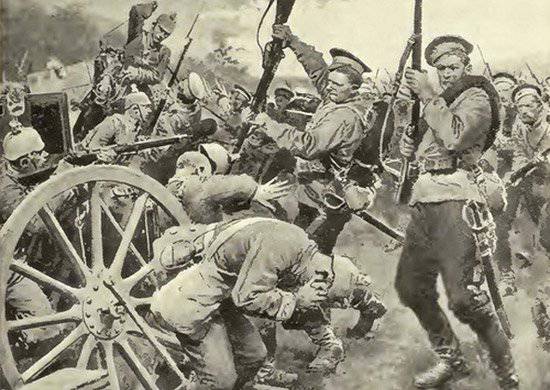
Russian bayonet attack in East Prussia. Promotional sheet. 1914
To be continued ...
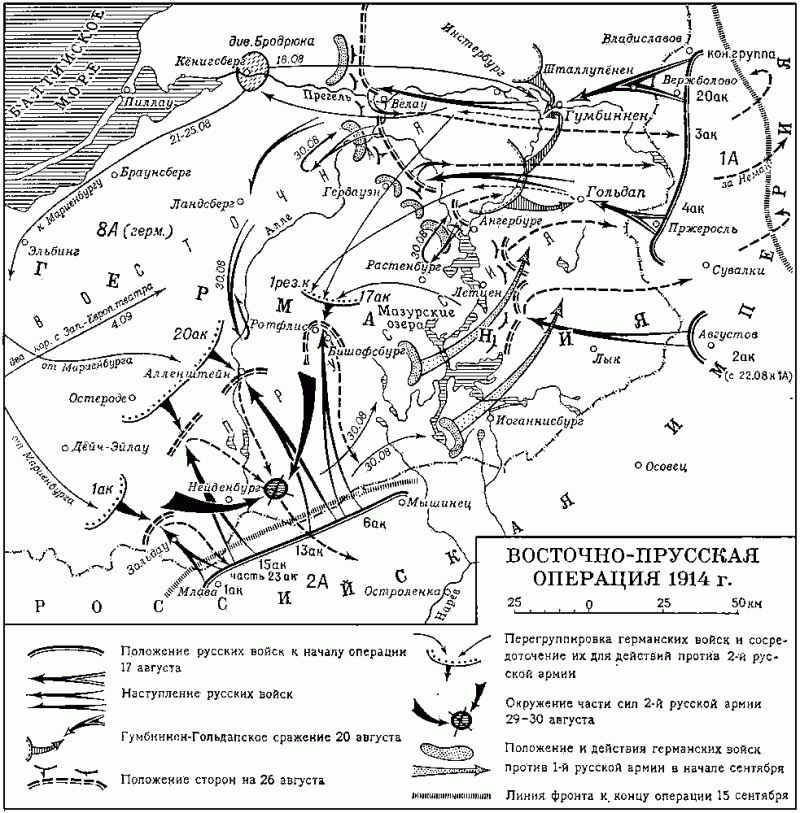
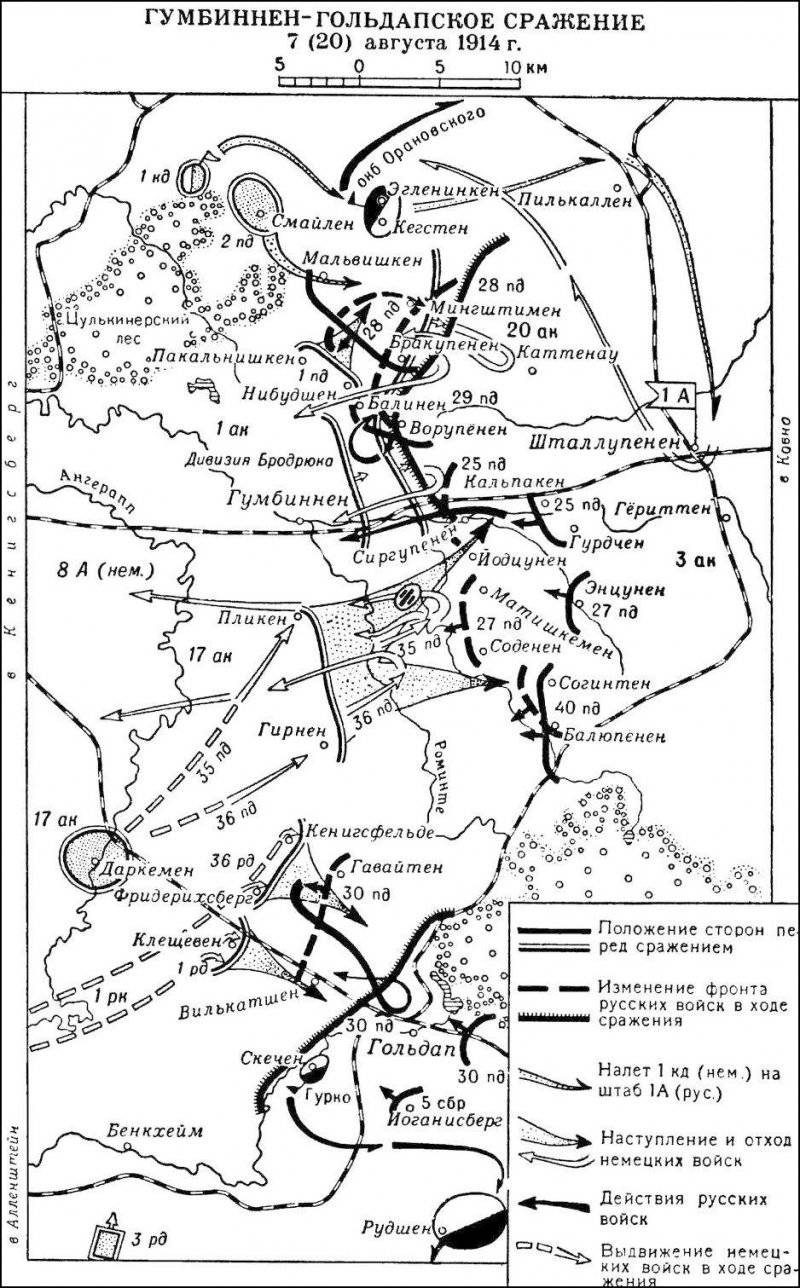
Information